Introducing Answer Engines – the New Frontier of Search
The way we find information online is undergoing a fundamental transformation. Traditional search engines with their familiar blue links are being rapidly supplemented – and in some cases replaced – by AI answer engines that deliver direct, personalized responses to user queries.
ChatGPT now serves over 800 Billion weekly active users, Perplexity handles more than 100 million queries weekly, and Google’s AI Overviews and AI Mode are used by over two billion users and are increasingly dominant in search results. The future isn’t just coming – it’s already here.
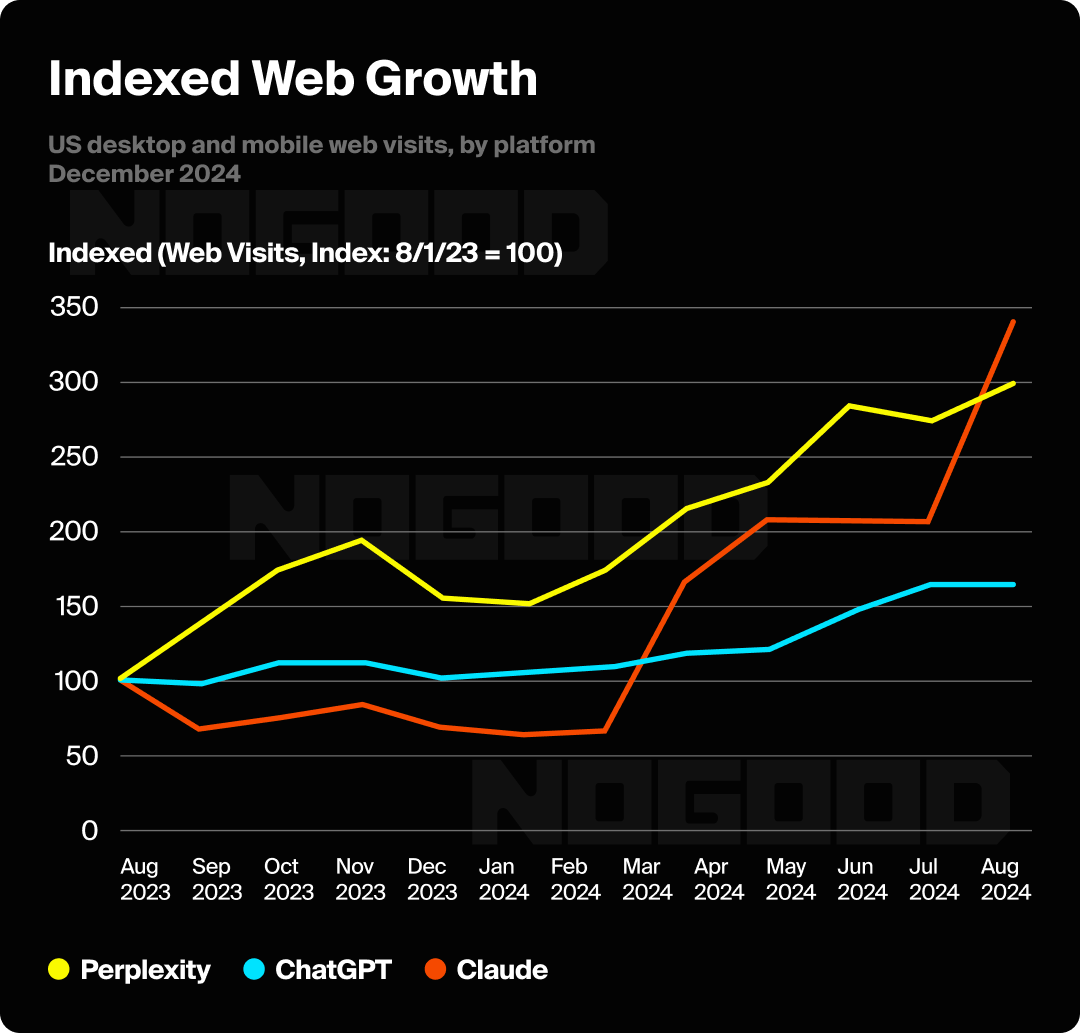

This shift from conventional search engines to answer engines represents a crucial evolution for brands, marketers, and content creators. While SEO remains important, a new discipline has emerged: Answer Engine Optimization (AEO). Understanding and implementing AEO strategies is becoming essential for maintaining visibility as AI increasingly mediates the information discovery process.

This comprehensive guide will walk you through everything you need to know about AEO, from understanding the fundamentals to implementing practical strategies that ensure your content remains visible and valuable in an AI-driven world.
What you’ll learn:
- The basics of Answer Engine Optimization (AEO) and how it differs from SEO, focusing on AI-driven content visibility.
- Techniques to optimize content for AI systems like ChatGPT, Claude, and Google AI, with an emphasis on clarity and authority.
- Steps to implement an AEO strategy, covering research, content creation, and distribution.
- The role of schema markup and technical SEO in improving AI access and ranking.
- How to measure AEO success and build authority across AI platforms.
What is Answer Engine Optimization?
Answer Engine Optimization (AEO) refers to strategies and techniques for optimizing content to be effectively extracted, cited, and featured by LLMs and answer engines like ChatGPT, Claude, Perplexity, and Google’s AI Overviews.
The terminology in this space can be confusing, with several overlapping concepts:
- AEO (Answer Engine Optimization): Focuses on creating content that’s easily extracted and cited by AI systems, emphasizing clarity, conciseness, and direct answers to specific questions.
- GEO (Generative Engine Optimization): Techniques for creating high-quality, information-rich content designed to serve as reliable source material for generative AI.
- LLM SEO: Optimization strategies specifically targeting search engines powered by large language models, prioritizing semantic relevance and comprehensive coverage.
- LLMO (Large Language Model Optimization): A broader, holistic approach to optimizing content, structure, and metadata for discoverability, interpretability, and influence within AI-generated outputs across various platforms — not just search.
- AIO (AI Overviews): Techniques specifically tailored for Google’s AI-powered search algorithms and features appearing at the top of search results.
For simplicity, we’ll use “AEO” throughout this guide, as the core principles remain consistent regardless of terminology.
How AEO Differs From Traditional SEO
While traditional SEO aims to improve website rankings in search engine results pages (SERPs) through keywords, backlinks, and technical enhancements, AEO has a fundamentally different goal:

This shift requires a new approach to content creation and optimization. As SEO expert George Chasiotis notes, “AEO comes from Google’s evolution from keyword-driven search to one that uses machine learning and NLP to parse queries and serve content to match intent. Authority, user intent, and topical relevance are key ranking factors.”
Recent data from Bain illustrates this transformation, showing that 80% of searchers now rely on “zero-click” results in at least 40% of their searches, reducing organic web traffic by an estimated 15-25%. This makes optimizing for AI visibility no longer optional but essential.
Understanding Answer Engines
Answer engines are LLM-powered platforms that deliver direct, concise responses to user queries without requiring users to visit multiple websites. Unlike traditional search engines that provide links to explore, answer engines parse questions, extract relevant information from various sources, and synthesize comprehensive answers.
These systems combine conventional search capabilities with large language models (LLMs) and Retrieval Augmented Generation (RAG) to generate and retrieve responses from multiple sources. Key players in this space include:
- ChatGPT and Claude: Conversational AI assistants that provide detailed responses to queries.
- Perplexity: An agent agnostic specialized search platform that combines AI synthesis with cited sources.
- Google’s AI Overviews and AI Mode: AI-generated summaries appearing at the top of search results; with AI mode, you can turn it into a conversation.
- Microsoft Copilot: An AI companion that integrates with search capabilities.
What makes answer engines particularly powerful is their ability to:
- Understand natural language queries with remarkable accuracy
- Pull information from multiple sources simultaneously
- Synthesize information into coherent, direct answers
- Provide citations to original sources (in some cases)
- Continuously improve through user feedback and model updates
This evolution represents a significant change in how users interact with information online. Rather than clicking through multiple pages, users now expect immediate, accurate answers directly in the interface, making brand visibility in these answers critical for digital success.
Key Variables Impacting AEO by Model
Goodie launched the largest AI search visibility study, their AEO periodic table, breaking down the factors that influence brand visibility across models. It’s important to understand these factors before jumping in and implementing a strategy.
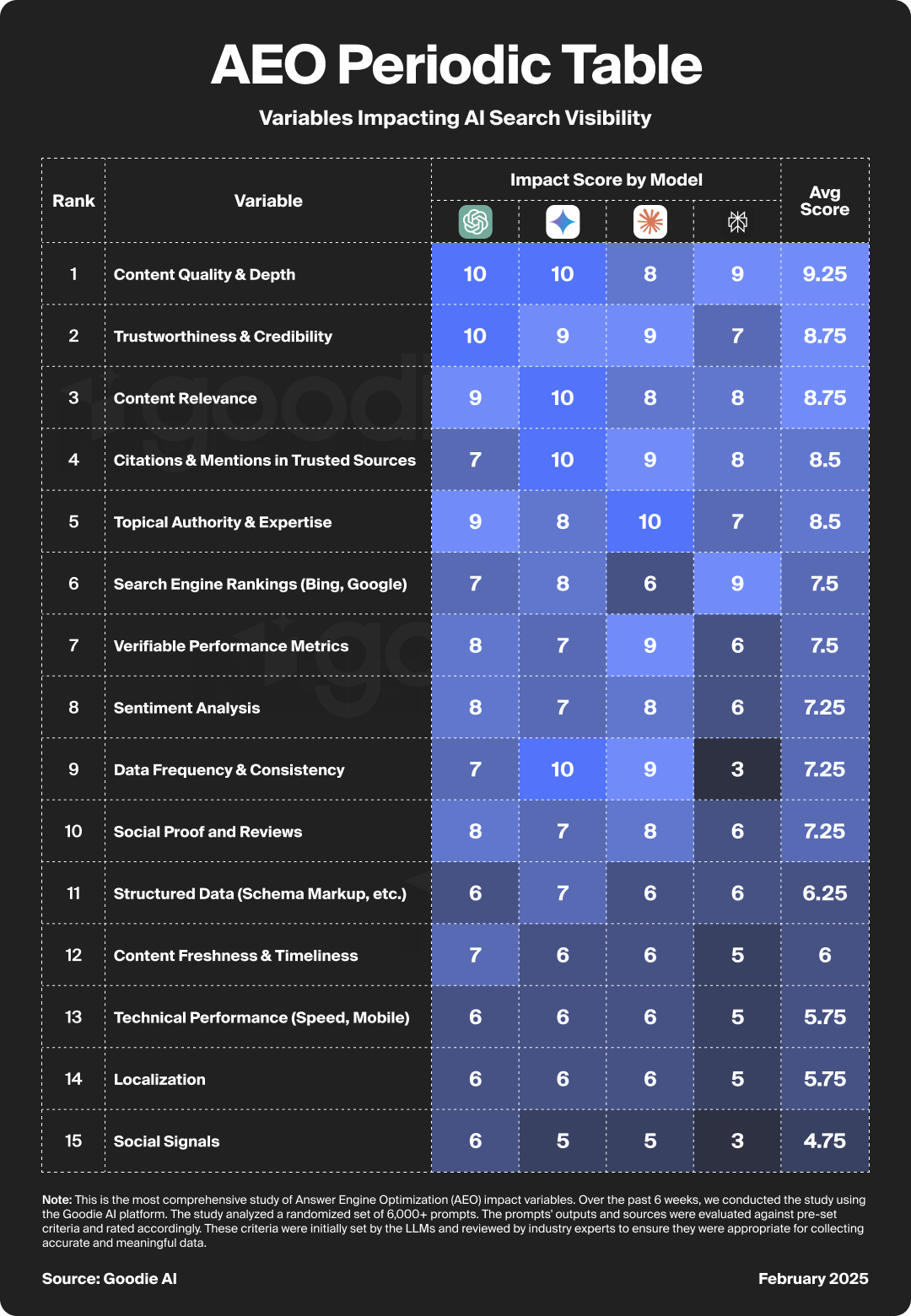
How to Implement an AEO Strategy Framework
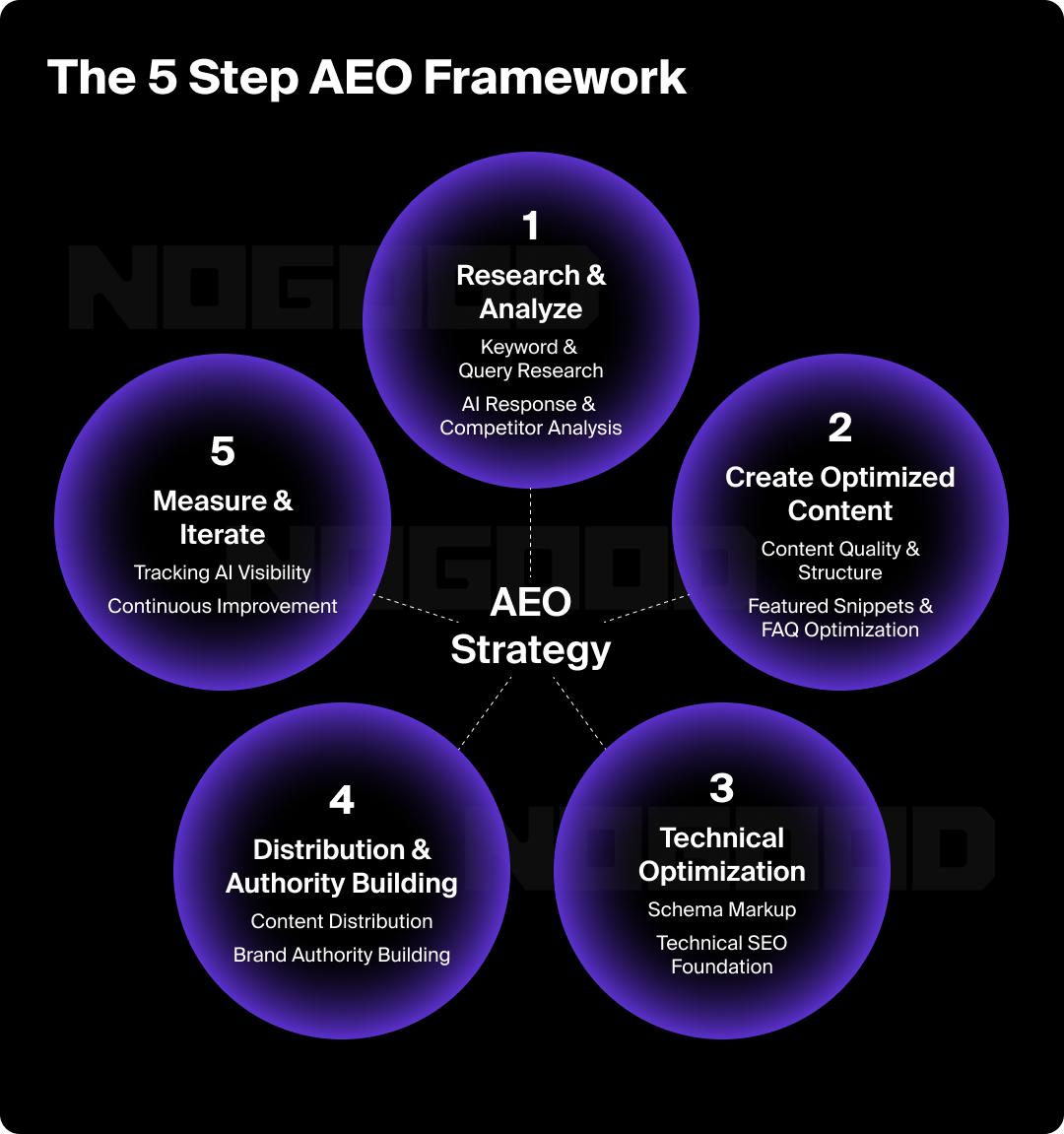
Based on insights from leading experts across the industry, we’ve developed a comprehensive five-step framework for effective Answer Engine Optimization:
1. Research and Analyze
The foundation of any successful AEO strategy begins with thorough research and analysis to how your brand is perceived by these LLMS and Answer Engines. You can leverage AEO tools like Goodie to give you a full analysis into how your brand is perceived by LLMs and get a visibility score, sentiment analysis, and a breakdown of performance against competition.
Prompts and Query Research
AEO-focused topic research differs significantly from traditional approaches, emphasizing questions or prompts and conversational phrases over short keyword strings. This aligns with how users interact with voice assistants and AI chatbots.
Action items:
- Research specific questions people ask using tools like “People Also Ask” boxes, AlsoAsked.com, and AnswerThePublic.
- Focus on long-tail keywords and conversational queries that mirror natural speech patterns.
- Identify semantic keywords and contextually relevant phrases using tools like Google Keyword Planner and Semrush’s Topic Research.
- Use AI tools like ChatGPT with this specific prompt template:
- “Generate a list of long-tail keywords, conversational queries, and contextually relevant phrases related to [YOUR TOPIC] that address different types of user intent (informational, navigational, commercial, transactional). Include common user questions, semantic terms, and key entities for comprehensive content. Highlight areas where users often seek deeper insights or specific solutions.”
Here’s a real-world example to outline this process: A financial advisory firm analyzed questions in “People Also Ask” boxes for queries like “retirement planning” and discovered users were specifically asking about “retirement planning in economic downturns” and “retirement planning for self-employed individuals” — niche topics they hadn’t previously addressed that became the foundation of their AEO content strategy.
Competitor and AI Response Analysis
It’s essential to understand how your brand and content are being represented — or overlooked — by these systems, as knowing what content AI systems currently favor helps shape your strategy. Competitor and AI response analysis helps you identify which queries trigger AI overviews, what formats AI favors (like lists, tables, or summaries), and which competitors consistently earn citations. This insight allows you to adapt your content strategy for maximum visibility and influence in AI-driven search experiences.
Action items:
- Track which queries trigger AI-generated overviews in Google using the free Google AI Overview Impact Analysis Chrome extension.
- Analyze AI response structures and formats (lists, tables, direct answers) for your target queries.
- Identify competitors frequently appearing in AI-generated answers and examine their content structure.
- Run your brand name through AI assistants to understand how you’re currently portrayed.
Pro tip: Create a spreadsheet to track:
- Target queries
- Whether they trigger AI Overviews
- Sources cited in these overviews
- Content format/structure used
- Your current visibility vs. competitors
2. Create Optimized Content
Once your research is complete, focus on creating content specifically designed for AI consumption.
Content Quality and Structure
AI systems prioritize content that is clear, comprehensive, and well-structured. High-performing content in the AI era goes beyond strong writing. It needs to be designed for how machines interpret and prioritize information. Clear formatting, semantic structure, and content modularity help AI systems parse and extract meaningful insights with ease.
Well-structured content not only boosts accessibility for readers but also increases the likelihood of being selected for AI summaries, voice responses, and zero-click results. When content is easy to navigate, logically ordered, and rich in context, it becomes far more effective at signaling authority and relevance to both AI and human audiences.
Action items:
- Begin with a direct answer to the primary question within the first 50 words.
- Use descriptive H2 and H3 headings, formatted as questions where appropriate.
- Create a logical hierarchy with information flowing from basic to advanced concepts.
- Break up text with bullet points, numbered lists, and comparison tables.
- Incorporate authoritative citations, quotations, and up-to-date statistics.
- Ensure content aligns with E-E-A-T principles (Experience, Expertise, Authoritativeness, Trustworthiness).
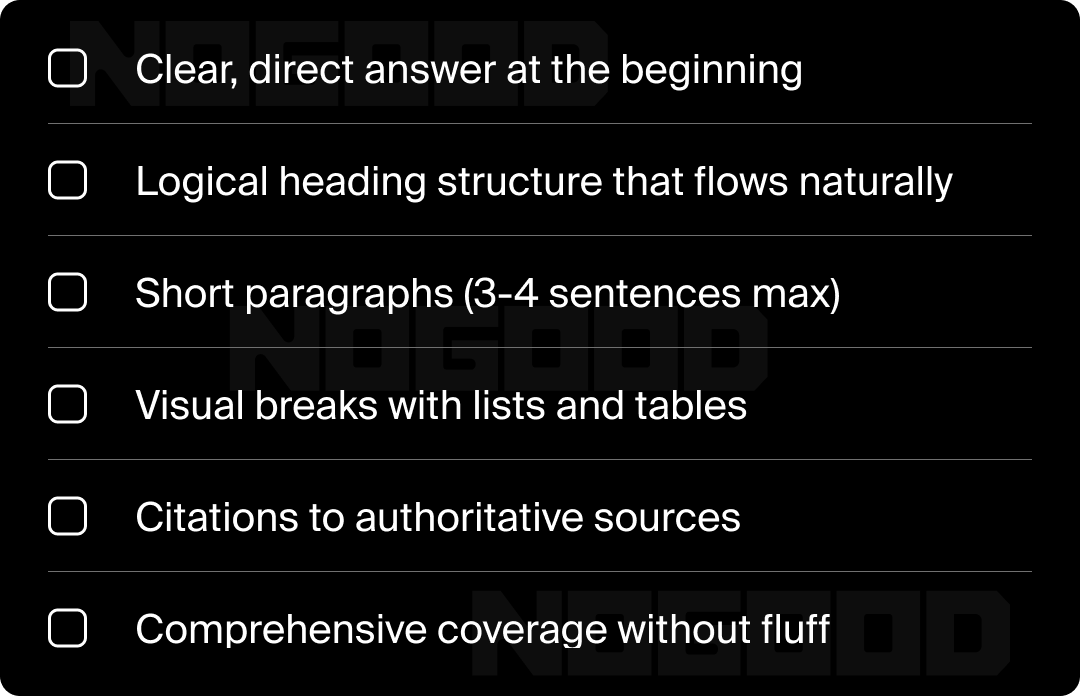
Featured Snippets and PAA Optimization
Featured snippets are prime real estate in search and, increasingly, the foundation for how AI systems generate answers. Earning these spots requires content that delivers concise, well-structured responses tailored to query intent.
By understanding how search engines extract and highlight information, brands can format their content to align with snippet-friendly patterns like short definitions, step-by-step lists, and comparison tables. Snippets not only increase visibility but also establish authority and improve the chances of being cited in AI-generated responses across search and assistant platforms.
Action items:
- Structure critical information in 40-50 word paragraphs optimized for featured snippets.
- Format appropriate content as numbered lists for “how-to” queries.
- Create comparison tables for “vs” or “best” queries.
- Monitor “People Also Ask” questions related to your topic and create specific content sections addressing each one.
- Include a dedicated FAQ section using proper schema markup.
Structure tip: For each main topic, include:
- A clear definition or direct answer (40-50 words)
- Supporting evidence or examples
- Visual element where appropriate (table, list)
- Citation to an authoritative source
As Rand Fishkin, CEO of Sparktoro, notes: “If you want LLMs to write with your brand’s name, present clear, consistent facts in well-structured content across multiple authoritative sources.”
3. Technical AEO
Technical elements play a crucial role in ensuring AI systems and crawlers can properly access and understand your content.
Schema Markup Implementation
Schema markup acts as a bridge between your content and AI systems, providing structured, machine-readable data that clarifies context, intent, and hierarchy. By tagging content with the appropriate schema — like FAQ, HowTo, or Product — you help search engines and large language models understand exactly what your page offers, increasing the chances of enhanced search features, better indexing, and inclusion in AI-driven results.
Proper implementation not only improves visibility in SERPs but also strengthens your content’s eligibility for voice search, rich snippets, and AI assistant responses.
Action items:
- Implement FAQ schema for frequently asked questions.
- Use HowTo schema for step-by-step guides.
- Apply QAPage schema for community Q&A content.
- Consider the emerging /llms.txt standard for AI-friendly content.
- Use Product, Review, and LocalBusiness schemas where appropriate.
Here’s a simple example of FAQ schema in JSON-LD format:
{
"@context": "https://schema.org",
"@type": "FAQPage",
"mainEntity": [{
"@type": "Question",
"name": "How to optimize for answer engines?",
"acceptedAnswer": {
"@type": "Answer",
"text": "Focus on clear, direct answers using proper structured data and comprehensive, authoritative content."
}
}]
}
Implementation tip: Use Google’s Structured Data Testing Tool or Schema Markup Validator to verify your implementation before publishing.
Technical SEO Foundation
Technical SEO is the backbone of AI visibility. Without it, even the best content can be overlooked. A well-optimized site ensures that AI systems and search engines can efficiently crawl, understand, and index your pages. Fast load times, mobile responsiveness, clean HTML, and structured internal linking all contribute to a seamless user experience that machines recognize and reward.
By addressing technical performance and accessibility, you create a reliable environment where your content can be surfaced more consistently in AI-driven results and enhanced search features.
Action items:
- Achieve page load speeds under 2.5 seconds (Core Web Vitals).
- Ensure mobile responsiveness across all devices.
- Use semantic HTML with proper heading structure.
- Implement secure HTTPS protocols.
- Create clear site architecture with logical internal linking.
- Use descriptive, keyword-rich URLs.
- Optimize image alt text and file names.
Quick win: Run your key pages through PageSpeed Insights and fix the highest-impact issues first.
4. Distribution and Authority Building
For AI to reference your content, it must recognize your brand as an authoritative source.
Content Distribution
Content distribution plays a critical role in boosting your visibility across AI systems by expanding your digital footprint beyond your own website. The more your content is shared, cited, and engaged with across reputable platforms, the more signals AI systems receive about your authority and relevance.
Diversifying your content formats and syndicating them across high-impact channels — like industry publications, video platforms, and community forums — not only reaches a wider audience but also increases the likelihood of being referenced in AI-generated responses. Strategic distribution ensures your content is where both your audience and AI are actively looking.
Action items:
- Identify 3-5 key platforms where your audience is active and that frequently appear in AI citations.
- Repurpose your content into multiple formats (blog posts, videos, podcasts, infographics).
- Contribute guest articles to authoritative industry publications.
- Participate actively in relevant online communities (Reddit, Quora, industry forums).
- Leverage social media platforms to amplify reach.
- Encourage user-generated content and engagement.
Distribution matrix:
- Primary website: Comprehensive, authoritative articles
- Industry publications: Guest posts highlighting expertise
- YouTube: Video explanations of complex topics
- LinkedIn/Medium: Thought leadership content
- Reddit/Quora: Direct answers to community questions
Building Brand Authority
Establishing brand authority is key to earning trust — not just from users, but also from AI systems trained to surface reliable, expert sources. The more consistently your brand is associated with credible insights, unique data, and authoritative voices, the more likely it is to be featured in AI-generated answers. This means going beyond surface-level content and investing in original research, thought leadership, and strategic collaborations.
Action items:
- Build quality backlinks from authoritative sites using data-driven content.
- Showcase expertise through original research, surveys, and case studies.
- Maintain consistent branding and messaging across all platforms.
- Collaborate with industry influencers and thought leaders.
- Create data-rich content with unique insights.
- Establish a regular publishing schedule, showing consistent expertise.
Authority metrics to track:
- Domain Authority/Domain Rating
- Number of referring domains
- Brand mentions (with and without links)
- Citation in industry research
- Social shares and engagement
As Brendan Hufford points out, “AI tools look for MENTIONS across their training data. If your brand appears frequently alongside relevant terms in places that make it into training data, you’ll show up in AI responses.”
5. AEO Stack: Measurement and Management
AEO is an evolving discipline requiring continuous monitoring and adjustment, which is why it’s crucial to rely on a platform to help you connect your strategy end to end.
We can start with the out-of-the-box AI Search platforms that are natively built for AEO. Here is a breakdown of the leading AEO tools in the space and which one would make the most sense for your business and use case.
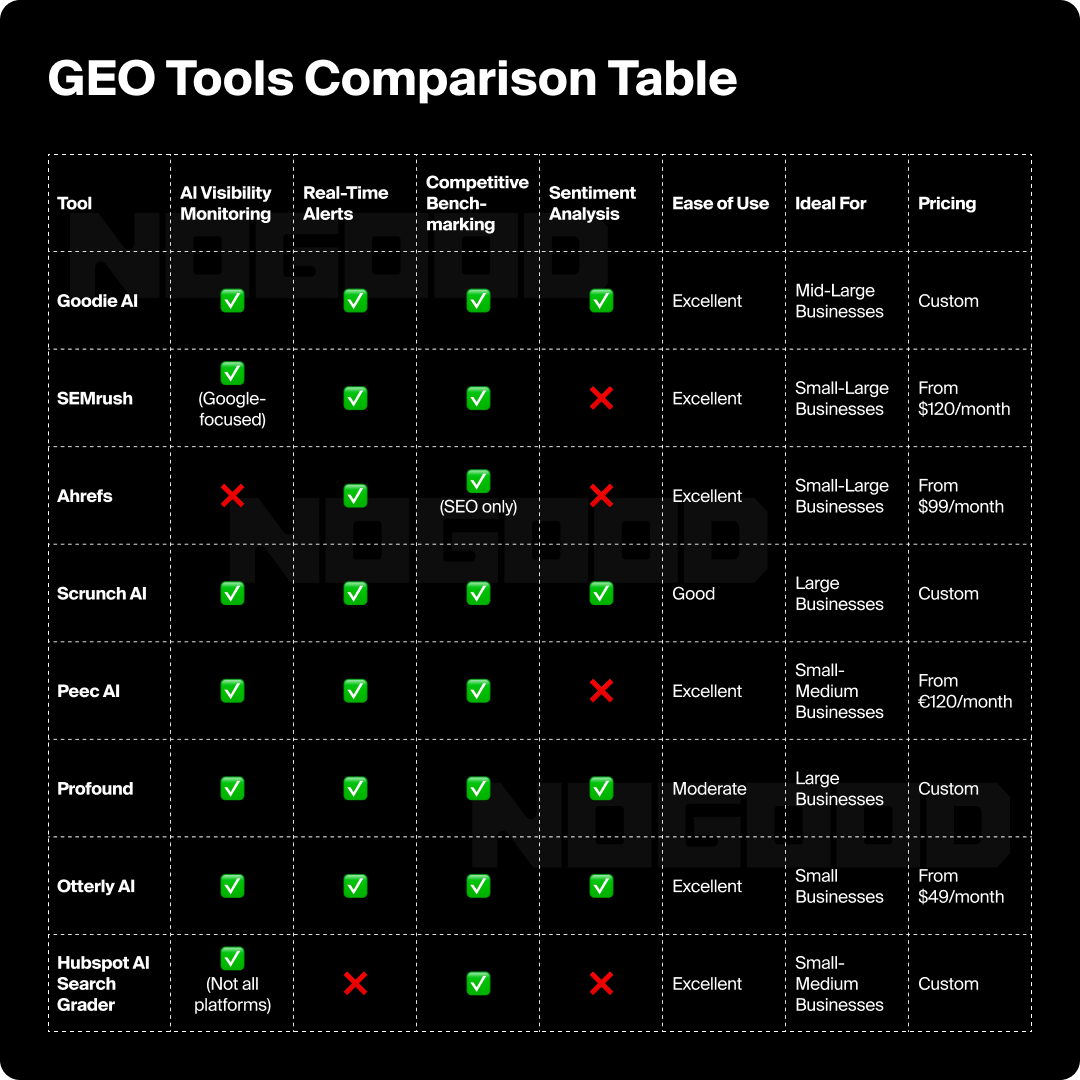
Tracking AI Visibility
Tracking AI visibility allows you to measure the real impact of your content in an increasingly AI-driven search landscape. By monitoring when, where, and how your brand is featured in AI-generated responses, you gain insight into which strategies are working — and which need refinement.
This data-driven approach helps identify high-performing content formats, optimize for better placements, and ensure your brand stays top-of-mind (and top-of-result) as AI evolves. Consistent tracking also supports smarter iteration cycles, allowing you to adapt your content and SEO efforts to stay aligned with how AI systems surface and rank information.
Action items:
- Use tools like Google’s AI Overview Impact Analysis extension to track AI citations.
- Create a system to monitor brand mentions in AI-generated responses across platforms.
- Track the percentage of your target queries where your brand appears in AI responses.
- Compare AI citation rates before and after implementing specific AEO strategies.
- Monitor which content formats and topics generate the most AI visibility.
KPIs to measure:
- AI visibility rate (% of queries where your brand appears)
- AI citation position (how prominently you’re featured)
- Conversion from AI mentions to website visits
- Brand sentiment in AI responses
Continuous Improvement
The AI landscape is constantly evolving, requiring ongoing refinement.
Action items:
- Analyze top-performing content for common elements and double down on successful formats.
- Regularly update high-performing content with fresh data and examples.
- A/B test different content structures to identify what AI systems prefer.
- Pivot away from underperforming strategies based on data.
- Stay updated on changes to AI systems through industry news and adjust accordingly.
Iteration schedule:
- Weekly: Check AI visibility metrics
- Monthly: Update existing content with new information
- Quarterly: Conduct larger content audits and strategy adjustments
- Ongoing: Monitor industry news for AI algorithm updates
Common AEO Pitfalls to Avoid
As you implement your AEO strategy, be aware of these common mistakes:
- Keyword stuffing and unnatural language: AI systems prioritize natural, conversational content. Avoid excessive keyword repetition.
- Superficial content: Thin content that lacks depth won’t establish the expertise needed for AI citations. Aim for comprehensive coverage.
- Ignoring structured data: Missing schema markup reduces AI’s ability to understand your content’s purpose and structure.
- Neglecting mobile optimization: Poor mobile experience can significantly impact how AI systems evaluate your content quality.
- Focusing solely on Google: While Google is important, diversify your optimization for multiple AI platforms.
A 30-Day AEO Action Plan
Based on expert insights, here’s a practical 30-day plan you can implement immediately:
Week 1: Research and Analysis
- Identify 10-15 target queries you want to rank for in AI responses.
- Analyze current AI responses for these queries using Chrome extensions.
- Audit your existing content for AEO-friendliness.
- Research competitor content that’s frequently cited.
Week 2: Content Optimization
- Restructure one high-value existing piece of content with proper headings, concise answers, and enhanced structure.
- Create a comprehensive FAQ page with schema markup.
- Develop one new piece of content specifically designed for AI citation.
- Implement proper schema markup across key pages.
Week 3: Technical and Distribution
- Fix any technical SEO issues affecting crawlability.
- Optimize page speed for key landing pages.
- Distribute your optimized content across multiple platforms.
- Reach out to industry publications for guest posting opportunities.
Week 4: Measurement and Iteration
- Track initial results of your optimization efforts.
- Identify top-performing content elements and formats.
- Make adjustments based on initial data.
- Develop an ongoing content calendar focused on AEO.
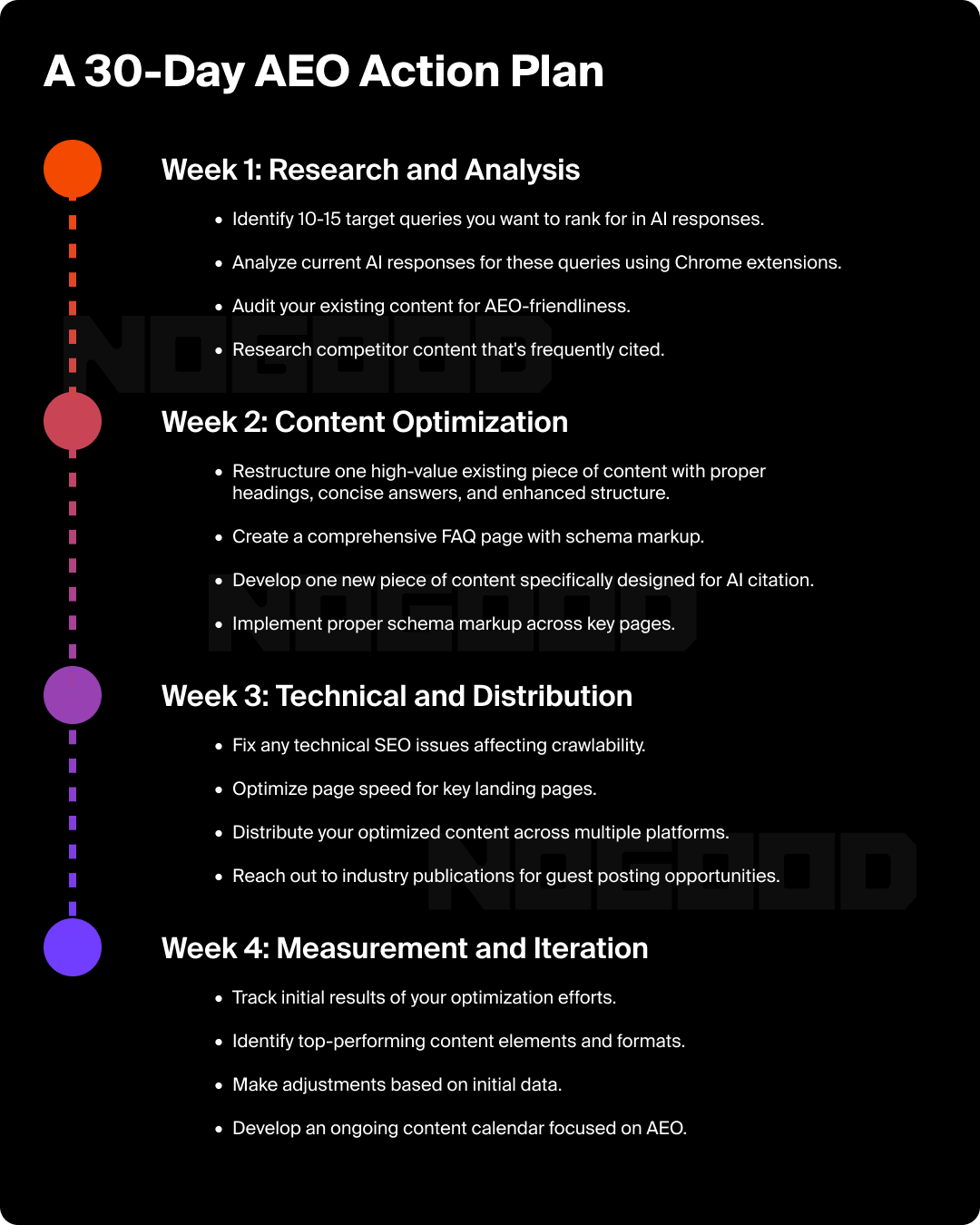
Looking Ahead: The Future of AEO
The field of Answer Engine Optimization is rapidly evolving. As AI systems become more sophisticated, optimization strategies will need to adapt. Some trends to watch:
- Multimodal content optimization: As AI becomes better at interpreting images, video, and audio, optimization across multiple content types will become more important.
- Personalization: AI systems are customizing responses based on user preferences and history, creating new challenges and opportunities for optimization.
- Ethical considerations: As manipulation techniques emerge, AI platforms are implementing safeguards against adversarial optimization, making authentic authority more valuable long-term.
- First-party data emphasis: As privacy concerns grow, businesses will have to leverage their own audience data for content creation.
The Time for AEO is Now
The shift toward AI-mediated information discovery represents one of the most significant changes in digital marketing since the rise of social media. As traditional search gives way to AI-powered answer engines, brands must adapt their strategies to maintain visibility and influence.
By implementing the AEO framework outlined in this guide — researching thoroughly, creating optimized content, implementing technical best practices, building authority, and continuously measuring results — you can position your brand for success in this new landscape.
The fundamentals of quality content remain unchanged; authority, relevance, and user value are still paramount. What’s changing is how that content needs to be structured, distributed, and optimized to ensure it remains visible.
Companies that embrace AEO now will establish a competitive advantage that becomes more and more valuable as AI continues to transform how people find and consume information online. The question isn’t whether to implement AEO — it’s how quickly you can start.







